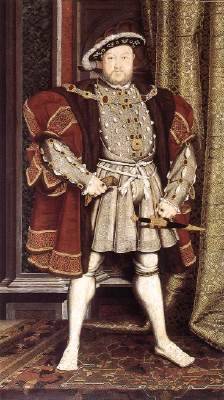
This page briefly discusses the role of sport
in the life of England's King Henry VIII.
By
Harvey Abrams, BS, MAT, Ph.d/abd
Olympic and Sport Historian

Henry VIII was King of England from 1509 until his death in 1547.
He was just 18 years old when he was crowned king.
He is famous as a strong monarch who renounced the authority of the Pope and the Catholic Church in Rome.
The Catholic Church had emerged with power at the same time the Roman Empire collapsed in the fifth century, and for a thousand years increased its power and influence throughout all of Europe. But power struggles within the Church led to the Protestant Reformation by Martin Luther in Switzerland, as well as the English Reformation by Henry VIII in England.
Henry VIII was a King who needed to have children to carry on his royal blood line. His wife bore him a baby girl -- but he wanted a male heir to the Tudor line. Henry sought permission from the Pope for a divorce. When this failed -- Henry and his Parliament created laws that removed the authority of the Pope and the Roman Catholic Church in England. The Anglican Church, which had already existed for 800 years, now became the Church of England with the King as its "pope." Henry then divorced his wife -- and famously went on to have a total of six wives:
He had three children from these wives, all eventually became monarchs:
This page concentrates on King Henry's activities as a sportsman -- we can't really call him an athlete.
There are no known images of Henry VIII showing sport activity -- only portraits such as the one on this page. At the bottom I provide you with links to other sites where you might find more details and images.
In studying sport history during this time period you must remember that there was no leisure time for most people -- life was rather harsh and only aristocrats took part in most "sport" -- jousting, tennis, archery, hunting. The common people did have their sports, of course, but nothing comparable to sport as we know it today. There were football games played -- with no rules and goals a mile apart -- games where people got broken necks, legs and sometimes killed each other.
Many activities were related to animals such as bear baiting, and almost always involving gambling. One of the few sources of information about sport history is found in the laws of the Kings and Queens, such as Henry VIII and Elizabeth I. These laws either outlawed sports (such as bowling) or required sports (such as archery) by James I (1618) for political, cultural or religious reasons. Sometimes just to control the rowdy behavior of the crowds. (Sound familiar to some of you soccer fans)?
But the sources clearly show that Henry VIII was a talented wrestler and archer, and that he enjoyed jousting, bowling and playing tennis.
The sport event most often mentioned in history books is about Henry's wrestling match with the King of France. In 1520 he met Francis I of France, in Flanders, at the 'Field of the Cloth of Gold' to make an alliance between their countries. For over two weeks the English and French Kings negotiated a peace treaty and during that time enjoyed sports events and other diversions in a grand display of power and wealth. Historians record that the two kings wrestled and that French King Francis, although smaller, threw King Henry to the ground.
Other historical sources record that Henry was a very good archer, able to hit a target from 220 yards with his long bow.
King Henry was also very fond of jousting and had magnificent suits of armour made for these events. On the basis of one of these suits, he was six feet, two inches tall, and slim at the time this particular suit was made. He had a sports complex at his Hampton Court Palace where there was an area used for jousting (called tilting) and a tennis court. You can read about the sole remaining Tower at this sports complex here: Conserving Henry's Tiltyard Complex.
Henry was seriously injured while jousting when he was hit in the leg. I theorize that after his injury he was unable to actively perform any physical activity, and as a result gained an enormous amount of weight. He appears to be very fat in many of his later portraits. I have read one truly disgusting description of an event that ocurred after his death but I will not share it here until I investigate the source material for accuracy (a great item for forensic students and CSI fans today if true).
Review the sources below for details and additional mention of sports such as falconry.
NOTE: All links were checked and working on February 20, 2008
August 22, 2024 - links are being checked & updated as needed - in progress.